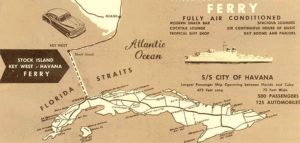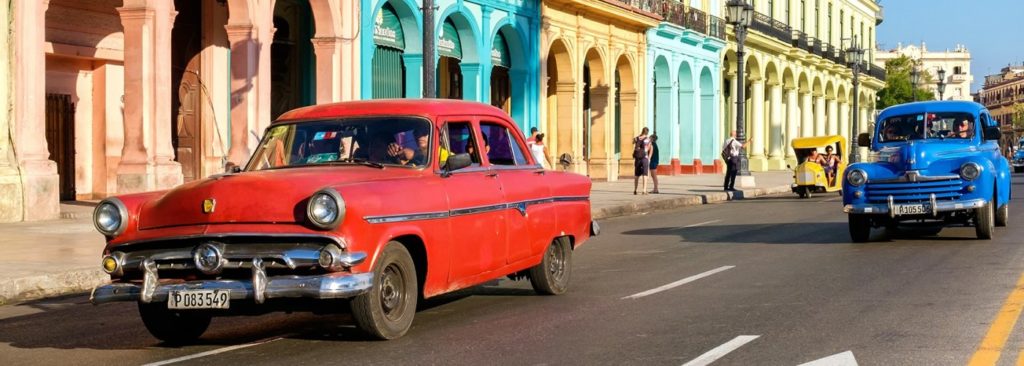TRAVELING FROM CAYO HUESO TO CUBA BEFORE 1959, WAS AS SIMPLE AS SEWING AND SINGING. THE FERRY
Cayo Hueso is the original name in Spanish for the island of Cayo Hueso or Key West. Spanish-speaking people today also use the term Cayo Hueso when referring to this island. It is said that the island was full of remains (bones) and that the island was the western key with a safe supply of water.
In 1890, Key West had a population of about 18,800 and was the largest and richest city in Florida. Half of the residents were said to be of Cuban origin, and Key West regularly had Cuban mayors, including the son of Carlos Manuel de Céspedes, the father of the Republic of Cuba, who was elected mayor in 1876. Cubans have participated actively in the development of 200 factories in the city, a production of 100 million cigars annually. José Martí made several visits to seek recruits for the independence of Cuba from 1891 and founded the Cuban Revolutionary Party during his visits to Key West.
https://youtu.be/xiMGSXBMeAU
CAYO HUESO TRIP (VIDEOS)
After the occupation of Havana by England, the Cayo was considered ceded to them, which did not pay much attention to the place, the Cubans residing there were transferred to Havana and soon the Cayo began to be used by Cuban and Bahamian fishermen.
Once the United States achieved its independence, by order of February 7, 1822, on March 25, 1822, Lieutenant Matthew C. Perry of the American Navy arrived in Key West on the Shark (Shark) and planted the American flag claiming the key. as the property of the United States. Perry proceeded to change the name to “Thompson’s Island” in honor of Secretary of the Navy Smith Thompson and named the port “Port Rodgers” in honor of John Rodgers, the hero of the war of 1812. Neither name remained, without However, Key West has remained the property of the United States to the present.
THE FERRY CAYO HUESO-CUBA
Traveling to the United States from Cuba, before the Revolution, was something as simple as sewing and singing.
The Ferry, for the price of $ 30, allowed you to travel with your car or bring one or more from Miami. This was a highly profitable business, buying used cars and taking them to Cuba, they were cars of little use, in excellent condition, and very cheap.
The stretch of the Vía Blanca that runs from the Ciudad Deportiva to the beginning of Santos Suárez, the so-called Puente de Agua Dulce, was packed with used cars for sale that had been brought from the United States. Not a few dreamed at that time of buying a Ford to which you had to pass your hand a bit for just 50 pesos. But for 200 or 300, it was possible to buy a car in very good condition and almost new.
The North American company Taylor was the one who operated the Ferry City of Havana, which had the capacity to transport about 500 passengers per trip who paid $ 30.00 (Cuban pesos or dollars) per one-way trip including cabotage. Of course, there were several cabotage cars; up to 125.
The frequency of trips Havana-Key West was: Monday, Wednesday, and Friday to Key West – from 10 am to 4 pm on Tuesday, Thursday, and Saturday to Havana from 10.00 am to 4.30 pm.
The boat docked at the Hacendados embouchure, Atares cove, in the bay of Havana. Once there, the travelers mounted in their cars crossed a special ramp and immediately strolled freely through the streets of the Cuban capital. The same thing happened in Key West, where an old ferry terminal was refurbished to cover this attractive route.
The Ferry cabins were air-conditioned, as were the rest of the facilities. In addition, it had some boutiques selling souvenirs, jewelry and other merchandise in the lobby of the cruise ship.
The City of Havana’s crew was multinational, captained by a Norwegian officer, with a Spanish first officer, and a Cuban one. There were two helmsmen, a radio operator, four watchmen, and a group of sailors. A musical group did their performances during the trip. As part of the recreation, on one occasion he performed at the Ferry Ernesto Lecuóna, accompanied by a tenor.
The Ferry operated until October 1962, when she made her last trip back to the United States, taking with her the diplomatic staff of the US embassy in Cuba and her cars.
VIAJAR DE CAYO HUESO A CUBA ANTES DE 1959, ERA TAN SENCILLO COMO COSER Y CANTAR. EL FERRY
Cayo Hueso es el nombre original en español de la isla de Cayo Hueso o Key West. Personas que hablan español hoy en día también usan el término Cayo Hueso al referirse a esta isla. Se dice que la isla estaba llena de restos (huesos) y que la isla era la llave occidental con un suministro seguro de agua.
En 1890, Cayo Hueso tenía una población de cerca de 18.800 y era la ciudad más grande y rica en la Florida. La mitad de los residentes se decía que eran de origen cubano, y Cayo Hueso regularmente tenían alcaldes cubanos, entre ellos el hijo de Carlos Manuel de Céspedes, el padre de la República de Cuba, que fue elegido alcalde en 1876. Los cubanos han participado activamente en el desarrollo de 200 fábricas en la ciudad, una producción de 100 millones de cigarros anuales. José Martí hizo varias visitas a buscar reclutas para la independencia de Cuba a partir de 1891 y fundó el Partido Revolucionario Cubano en sus visitas a Cayo Hueso.
https://youtu.be/dYoczIlKzMY
HISTORIA DE CAYO HUESO (VIDEOS)
Despues de la ocupación de la Habana por los Ingleses el Cayo fue considerado cedido a Inglaterra que no le hizo mucho caso al lugar, los cubanos residentes alli fueron trasladados a la Habana y pronto el Cayo empezó a ser usado por pescadores cubanos y de las Bahamas.
Logrado los Estados Unidos su independencia, por orden del 7 de febrero de 1822, el 25 de marzo de 1822 el teniente Matthew C. Perry de la marina americana llegó a Cayo Hueso en el Shark (Tiburón) y plantó la bandera americana reclamando al cayo como propiedad de los Estados Unidos. Perry procedió a cambiarle el nombre a “Thompson’s Island” en honor al secretario de la marina Smith Thompson y al puerto le llamó “Port Rodgers” en honor a John Rodgers, héroe de la guerra de 1812. Ninguno de los dos nombres permanecieron, sin embargo, Cayo Hueso ha permanecido propiedad de los Estados Unidos hasta el presente.
EL FERRY CAYO HUESO-CUBA
Viajar a los Estados Unidos desde Cuba, antes de 1959, era algo tan sencillo como coser y cantar.
El Ferry, por el precio de 30 dólares, permitía viajar con su carro o traer uno o varios de Miami. Este era un negocio altamente rentable, comprar autos usados y llevarlos a Cuba, eran carros de poco uso, en excelente estado y muy baratos.
El tramo de la Vía Blanca que comprende desde la ciudad Deportiva hasta el comienzo de Santos Suárez, el llamado Puente de Agua Dulce, se encontraba abarrotados de carros usados en venta que habían sido traídos desde Estados Unidos. No pocos soñaron en aquel tiempo comprarse un Ford al que había que pasarle un poco la mano en tan solo 50 pesos. Pero por 200 o 300, era posible adquirir un auto en muy buen estado y casi nuevo.
La Empresa norteamericana Taylor era quien operaba el Ferry City of Havana, el cual tenía capacidad para transportar unos 500 pasajeros por viaje que pagaban $30.00 (pesos cubanos o dólares) por viaje en un solo sentido incluyendo cabotaje. Por supuesto que de cabotaje iban autos varios; hasta 125.
La frecuencia de viajes Habana-Cayo Hueso era: Lunes, miércoles y viernes hasta Cayo Hueso (Key West)- de 10 am a 4 pm los martes, jueves y sábado hasta La Habana de 10.00 am a 4.30 pm.
La embarcación atracaba en el embocadero Hacendados, ensenada de Atares, en la bahía de La Habana. Una vez allí, los viajeros montados en sus autos cruzaban una rampa especial e inmediatamente paseaban libremente por las calles de la capital cubana. Lo mismo sucedía en Cayo Hueso, donde una antigua terminal de ferris fue reacondicionada para cubrir ese atractivo trayecto.
Los camarotes del Ferry tenían aire acondicionado, al igual que resto de las instalaciones. Además, contaba con algunas boutiques de ventas de souvenirs, joyas y otras mercancías en el lobby del crucero.
La tripulación del ‘City of Havana’ era multinacional, capitaneada por un oficial noruego, con un primer oficial español, y uno cubano. Habían dos timoneles, un radio-operador, cuatro veladores, y un grupo de marineros. Un conjunto musical hacía sus actuaciones durante el viaje. Como parte de la recreación, en una ocasión actuó en el Ferry Ernesto Lecuóna que se hacía acompañar por un tenor.
El Ferry funcionó hasta Octubre de 1962, cuando realizó su ultimo viaje de regreso a Estados Unidos llevando consigo al personal diplomático de la embajada estadounidense en Cuba y sus automóviles.
Agencies/ Wiki/ MemoriasCubanas/ Carlos RodriguezB. / Extractos/ Excerpts/ Internet Photos/ YouTube/ Arnoldo Varona/ www.TheCubanHistory.com
THE CUBAN HISTORY, HOLLYWOOD.



 TRAVELING from Cayo Hueso to Cuba before 1959, was as Simple as Sewing and Singing. The FERRY. * VIAJAR desde Cayo Hueso a Cuba antes del 1959, era tan Simple como Coser y Cantar. EL FERRY. Photos/Videos.
TRAVELING from Cayo Hueso to Cuba before 1959, was as Simple as Sewing and Singing. The FERRY. * VIAJAR desde Cayo Hueso a Cuba antes del 1959, era tan Simple como Coser y Cantar. EL FERRY. Photos/Videos.








